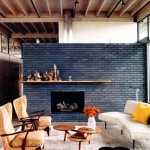Modern Traditional Homes: Interior Design Ideas
The concept of "Modern Traditional" interior design blends the comfort and familiarity of classic aesthetics with the clean lines and functionality of contemporary styles. This approach seeks to create spaces that are both inviting and sophisticated, honoring the past while embracing the present. Achieving a successful modern traditional interior requires a thoughtful balance of elements, careful consideration of color palettes, and a strong understanding of the principles that underpin both traditional and modern design philosophies.
Modern traditional design is not simply about placing antique furniture in a modern setting. It's a far more nuanced and deliberate process. The key lies in creating a harmonious dialogue between old and new, ensuring that neither style overwhelms the other. This can involve incorporating contemporary artwork into a traditionally furnished room, or conversely, using classic architectural details in a space with a very modern layout.
Key Considerations for Achieving a Modern Traditional Aesthetic
Successfully executing a modern traditional design requires careful consideration of several key areas. Paying attention to these fundamental aspects ensures a cohesive and balanced final result.
Color Palette and Material Selection: Color plays a crucial role in setting the tone of any room. In modern traditional design, neutral colors often form the foundation. Whites, creams, grays, and beiges provide a calming backdrop that allows other design elements to shine. These neutral hues create a sense of airiness and spaciousness, characteristics often associated with modern design. However, traditional elements are introduced through warmer tones and richer textures. Think of adding pops of color through accent pillows, artwork, or area rugs in shades like deep blues, greens, or burgundies. Wood is also a vital component. Natural wood tones, particularly in flooring, furniture, and architectural details, bring warmth and a sense of history to the space. Incorporating a mix of textures – smooth silks, plush velvets, woven linens, and textured wallpapers – can add depth and visual interest.
Furniture Selection and Arrangement: When selecting furniture for a modern traditional home, prioritize pieces that blend classic silhouettes with contemporary materials and detailing. Opt for comfortable upholstered sofas and armchairs with clean lines, rather than overly ornate designs. Consider incorporating antique or vintage pieces, but be mindful of their scale and proportion in relation to the rest of the room. These pieces can serve as focal points, adding character and a sense of history. The arrangement of furniture should promote both functionality and conversation. A well-placed area rug can define a seating area, while strategically positioned lighting can create a warm and inviting atmosphere. Avoid overcrowding the space with too much furniture; the goal is to create a sense of spaciousness and flow.
Lighting and Accessories: Lighting is essential for creating the right ambiance in a modern traditional home. A combination of natural light and artificial light sources is ideal. Maximize natural light by using sheer curtains or blinds that allow sunlight to filter through. Supplement natural light with a variety of artificial light sources, including recessed lighting, chandeliers, sconces, and table lamps. Chandeliers can add a touch of elegance and sophistication, while sconces provide soft, ambient lighting. Table lamps can be used to create pools of light in specific areas, adding warmth and intimacy. Accessories play a crucial role in adding personality and character to the space. Incorporate a mix of traditional and modern elements, such as antique mirrors, contemporary artwork, and decorative objects. Consider using framed prints, sculptures, and vases to add visual interest. Keep accessories curated and avoid clutter. The goal is to create a space that feels personal and inviting, without being overwhelming.
Incorporating Traditional Elements into a Modern Space
Successfully integrating traditional elements into a modern space requires a discerning eye and a careful approach. The goal is to create a harmonious blend that feels both timeless and contemporary.
Architectural Details: Architectural details can play a significant role in bridging the gap between traditional and modern design. If your home has existing traditional features, such as crown molding, wainscoting, or built-in bookshelves, highlight them. These details add character and a sense of history to the space. If your home lacks these features, consider adding them. Crown molding can be installed relatively easily and can instantly elevate the look of a room. Wainscoting can add texture and visual interest to walls. Built-in bookshelves can provide storage and display space. When incorporating architectural details, choose styles that are consistent with the overall aesthetic of the home. Avoid overly ornate or elaborate designs, as these can detract from the modern feel of the space.
Textiles and Patterns: Textiles and patterns can be used to add warmth, texture, and visual interest to a modern traditional home. Incorporate classic patterns such as floral prints, stripes, and plaids, but choose them in modern color palettes and scales. Use these patterns on accent pillows, curtains, and area rugs. Consider using textured fabrics such as velvet, linen, and silk to add depth and dimension to the space. Layering textiles is a great way to create a sense of comfort and visual interest. For example, layer a plush velvet throw over a linen sofa, or place a patterned rug over a hardwood floor.
Antique and Vintage Pieces: Incorporating antique and vintage pieces is an excellent way to add character and history to a modern space. However, it's important to choose pieces that are in good condition and that complement the overall aesthetic of the home. Consider using antique furniture, such as a vintage dresser or a Queen Anne chair, as focal points in a room. Antique mirrors can add a touch of elegance and sophistication. Vintage rugs can add warmth and character to floors. When incorporating antique and vintage pieces, be mindful of their scale and proportion in relation to the rest of the room. Avoid overcrowding the space with too many antique items; the goal is to create a balanced and harmonious look.
Modernizing Traditional Design Elements
Conversely, modernizing traditional design elements involves taking classic features and updating them with contemporary twists. This approach ensures that the design feels fresh and relevant, while still retaining a sense of heritage.
Streamlining Traditional Furniture: Instead of opting for heavily ornate furniture pieces typically associated with traditional design, consider streamlined versions. A classic wingback chair, for example, can be updated with a cleaner silhouette and modern upholstery in a neutral color. Similarly, a traditional dining table can be paired with modern chairs for a more contemporary look. This approach allows you to retain the essence of traditional design without sacrificing the clean lines and simplicity of modern aesthetics.
Updating Traditional Color Palettes: While traditional color palettes often feature rich, saturated hues, modernizing them involves opting for lighter, more muted tones. Instead of deep reds and golds, consider using soft grays, blues, and greens. These colors create a calming and sophisticated atmosphere that complements both traditional and modern elements. You can still incorporate pops of color through accessories and artwork, but keep the overall palette neutral and understated.
Reinterpreting Traditional Patterns: Traditional patterns, such as floral prints and damasks, can be reinterpreted in modern ways. This can involve using bolder scales, unexpected color combinations, or abstract designs. For example, a large-scale floral wallpaper in a contemporary color palette can add a dramatic touch to a modern traditional space. Alternatively, you can use traditional patterns sparingly, such as on accent pillows or window treatments, to add subtle visual interest.
Modern Lighting Fixtures with Classic Influences: Opt for lighting fixtures that incorporate classic shapes and materials but with modern finishes and detailing. A chandelier with clean lines and a brushed nickel finish, for example, can provide a touch of elegance without feeling overly traditional. Similarly, sconces with simple, geometric shapes can add a contemporary touch to a classically styled room. The key is to choose lighting fixtures that complement the overall aesthetic of the space, blending seamlessly with both traditional and modern elements.
By carefully considering these principles and incorporating a mix of traditional and modern elements, it is possible to create a modern traditional home that is both stylish and inviting. The key is to find a balance that reflects your personal taste and lifestyle, creating a space that you will enjoy for years to come.

25 Best Traditional Interior Design Ideas In 2024 Decorilla

8 Ways To Add A Modern Touch Traditional Decor

Traditional Interior Design Ideas For Your N Home Fabdiz

How To Decorate A Modern Home In Traditional Style House Of Vedvik
:strip_icc()/102670787-d2b264d36b054ab188246ec947f52cae.jpg?strip=all)
17 Traditional Living Room Ideas With Classic Design Details

Traditional N Home Decorating Ideas Designcafe

Elegant Contemporary Traditional Living Room Design Ideas

Interior Design Styles 101 The Ultimate Guide To Decorating In 2024 Decorilla

Traditional Home With Beautiful Interiors Bunch Interior Design Ideas

Redefining Modern And Traditional Home Design Jonite
Related Posts








